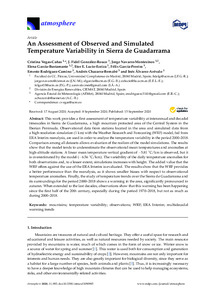Por favor, use este identificador para citar o enlazar este ítem:
http://hdl.handle.net/20.500.11765/12682
An assessment of observed and simulated temperature variability in Sierra de Guadarrama
Registro completo de metadatos
| Campo DC | Valor | Lengua/Idioma |
|---|---|---|
| dc.contributor.author | Vegas Cañas, Cristina | es_ES |
| dc.contributor.author | González Rouco, Jesús Fidel | es_ES |
| dc.contributor.author | Navarro, Jorge | es_ES |
| dc.contributor.author | García Bustamante, Elena | es_ES |
| dc.contributor.author | Lucio-Eceiza, Etor Emanuel | es_ES |
| dc.contributor.author | García-Pereira, Félix | es_ES |
| dc.contributor.author | Rodríguez Camino, Ernesto | es_ES |
| dc.contributor.author | Chazarra-Bernabé, Andrés | es_ES |
| dc.contributor.author | Álvarez Arévalo, Inés | es_ES |
| dc.date.accessioned | 2021-02-02T12:19:53Z | - |
| dc.date.available | 2021-02-02T12:19:53Z | - |
| dc.date.issued | 2020 | - |
| dc.identifier.citation | Atmosphere. 2020, 11(9), 985 | es_ES |
| dc.identifier.issn | 2073-4433 | - |
| dc.identifier.uri | http://hdl.handle.net/20.500.11765/12682 | - |
| dc.description.abstract | This work provides a first assessment of temperature variability at interannual and decadal timescales in Sierra de Guadarrama, a high mountain protected area of the Central System in the Iberian Peninsula. Observational data from stations located in the area and simulated data from a high-resolution simulation (1 km) with the Weather Research and Forecasting (WRF) model, fed from ERA Interim reanalysis, are used in order to analyse the temperatura variability in the period 2000–2018. Comparison among all datasets allows evaluation of the realism of the model simulations. The results show that the model tends to underestimate the observational mean temperatures and anomalies at high-altitude stations. A linear mean temperature vertical gradient of −5.81 ◦C/km is observed, but it is overestimated by the model (−6.56 ◦C/km). The variability of the daily temperature anomalies for both observations and, to a lesser extent, simulations increases with height. The added value that the WRF offers against the use of the ERA Interim is evaluated. The results show that the WRF provides a better performance than the reanalysis, as it shows smaller biases with respect to observational temperature anomalies. Finally, the study of temperature trends over the Sierra de Guadarrama and its surroundings for the period 2000–2018 shows a warming in the area, significantly pronounced in autumn. When extended to the last decades, observations show that this warming has been happening since the first half of the 20th century, especially during the period 1970–2018, but not as much as during 2000–2018. | es_ES |
| dc.description.sponsorship | This research was funded by CEI Moncloa UPM-UCM-Ciemat Cooperation Agreement: GuMNet (Guadarrama Monitoring Network) Initiative, Ministerio de Ciencia e Innovación: GreatModelS (RTI2018-102305-B-C21d), Ministerio de Ciencia e Innovación: GreatModelS (RTI2018-102305-B-C21d), Ministerio de Ciencia e Innovación: ILModels (CGL2014-59644-R/CLI). | es_ES |
| dc.language.iso | eng | es_ES |
| dc.publisher | Multidisciplinary Digital Publishing Institute | es_ES |
| dc.rights | Licencia CC: Reconocimiento CC BY | es_ES |
| dc.subject | Mountains | es_ES |
| dc.subject | Temperature variability | es_ES |
| dc.subject | Observations | es_ES |
| dc.subject | WRF | es_ES |
| dc.subject | ERA Interim | es_ES |
| dc.subject | Multidecadal warming trends | es_ES |
| dc.title | An assessment of observed and simulated temperature variability in Sierra de Guadarrama | es_ES |
| dc.type | info:eu-repo/semantics/article | es_ES |
| dc.relation.publisherversion | https://dx.doi.org/10.3390/atmos11090985 | es_ES |
| dc.rights.accessRights | info:eu-repo/semantics/openAccess | es_ES |
| Colecciones: | Artículos científicos 2019-2022 | |
Ficheros en este ítem:
| Fichero | Descripción | Tamaño | Formato | ||
|---|---|---|---|---|---|
| atmosphere-11-00985.pdf | 7,27 MB | Adobe PDF |  Visualizar/Abrir |
Los ítems de Arcimis están protegidos por una Licencia Creative Commons, salvo que se indique lo contrario.





